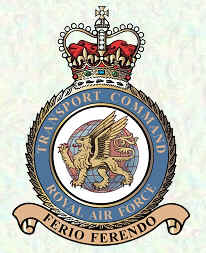RAF Transport Command
| Royal Air Force Transport Command | |
|---|---|
 RAF Transport Command badge | |
| Active | 25 March 1943–1 August 1967 |
| Country | |
| Branch | |
| Type | Command |
| Role | controlling Transport aircraft |
| Motto(s) | Latin: Ferio Ferendo ("I Strike by Carrying")[1] |
| Engagements | Second World War |
| Insignia | |
| crest heraldry | A golden griffon in front of a globe |
RAF Transport Command was a Royal Air Force command that controlled all transport aircraft of the RAF. It was established on 25 March 1943 by the renaming of the RAF Ferry Command, and was subsequently renamed RAF Air Support Command in 1967.
Contents
1 History
2 Aircraft operated
3 Operation Becher's Brook
4 North Greenland Expedition
5 Commanders-in-Chief
6 See also
7 References
7.1 Citations
7.2 Bibliography
8 External links
History
During the Second World War, it at first ferried aircraft from factories to operational units and performed air transport. Later it took over the job of dropping paratroops from Army Cooperation Command as well.
After the Second World War, it increased rapidly in size. It took part in several big operations, including the Berlin Airlift in 1948, which reinforced the need for a big RAF transport fleet.[2] The Handley Page Hastings, a four-engined transport, was introduced during the Berlin Airlift[3] and continued as a mainstay transport aircraft of the RAF for the next 15 years. In 1956, new aircraft designs became available, including the de Havilland Comet (the first operational jet transport), and the Blackburn Beverley. In 1959, the Bristol Britannia was introduced.[3]
During the 1960s the command was divided into three different forces:
- Strategic Force which operated the Comets and Britannias.
- Medium Range Force which operated Beverleys and Hastings.
- Short Range Force which operated helicopters, Scottish Aviation Pioneers and Scottish Aviation Twin Pioneers.
The principal RAF Transport Command functions of this period were support operations involving the evacuation of military personnel from the Suez Canal Zone prior and after the Suez Crisis of October–November 1956;[3] casualty evacuation from South Korea during the Korean War and from the Malaya during the Malayan Emergency; essential supplies to Woomera, South Australia, and ferrying personnel and supplies out to Christmas Island for the atomic bomb tests carried out by the UK. In addition, Transport Command ran scheduled routes to military staging posts and bases in the Indian Ocean region, Southeast Asia and the Far East, to maintain contact between the UK and military bases of strategic importance. It also carried out special flights worldwide covering all the continents bar Antarctica. Many varied tasks were undertaken during the 1950s.
The 1960s saw a reduction of the RAF and a loss of independence of the former functional commands. Transport Command was renamed Air Support Command in 1967.[4]
Aircraft operated
- Armstrong Whitworth Argosy
- Avro Anson
- Avro York
- Blackburn Beverley
- Bristol Britannia
- Consolidated B-24 Liberator (simply referred to as "Liberator" without the B-24 designation)
- de Havilland Comet
- de Havilland Devon
- Douglas Dakota
- Handley Page Hastings
- Hawker Siddeley Andover
- Lockheed C-130 Hercules
- Percival Pembroke
- Scottish Aviation Pioneer
- Scottish Aviation Twin Pioneer
- Short Belfast
- Vickers Valetta
- Vickers VC10
Operation Becher's Brook
Becher's Brook was a major operation of Transport command – the ferrying of 400 Canadair Sabre fighters from North America to the UK. This required pilots and ground crew to be transported to Canada. The Sabres were flown via Keflavik (Iceland) on to Shetland and from there to mainland Scotland.
North Greenland Expedition
Transport Command supported the British North Greenland Expedition a research expedition over two years on the Greenland ice.
Commanders-in-Chief
Commanders-in-Chief included:[5]
- 25 March 1943 – Air Chief Marshal Sir Frederick Bowhill
- 15 February 1945 – Air Marshal Sir Ralph Cochrane
- 24 September 1947 – Air Marshal Sir Brian Baker
- 31 March 1950 – Air Marshal Sir Aubrey Ellwood
- 1 January 1952 – Air Vice Marshal Robert Blucke
- 3 June 1952 – Air Vice Marshal Sir Charles Guest
- 15 March 1954 – Air Vice Marshal Sir George Beamish
- 15 October 1955 – Air Marshal Sir Andrew McKee
- 16 May 1959 – Air Marshal Sir Denis Barnett
- 30 April 1962 – Air Marshal Sir Edmund Hudleston
- 1 December 1963 – Air Marshal Sir Kenneth Cross
- 27 January 1967 – Air Marshal Sir Thomas Prickett
See also
- Aircraft
- List of aircraft of the Royal Air Force
- List of Royal Air Force commands
- Royal Air Force station
References
| Wikimedia Commons has media related to RAF Transport Command. |
Citations
^ Pine, L.G. (1983). A dictionary of mottoes (1 ed.). London: Routledge & Kegan Paul. p. 74. ISBN 0-7100-9339-X..mw-parser-output cite.citation{font-style:inherit}.mw-parser-output .citation q{quotes:"""""""'""'"}.mw-parser-output .citation .cs1-lock-free a{background:url("//upload.wikimedia.org/wikipedia/commons/thumb/6/65/Lock-green.svg/9px-Lock-green.svg.png")no-repeat;background-position:right .1em center}.mw-parser-output .citation .cs1-lock-limited a,.mw-parser-output .citation .cs1-lock-registration a{background:url("//upload.wikimedia.org/wikipedia/commons/thumb/d/d6/Lock-gray-alt-2.svg/9px-Lock-gray-alt-2.svg.png")no-repeat;background-position:right .1em center}.mw-parser-output .citation .cs1-lock-subscription a{background:url("//upload.wikimedia.org/wikipedia/commons/thumb/a/aa/Lock-red-alt-2.svg/9px-Lock-red-alt-2.svg.png")no-repeat;background-position:right .1em center}.mw-parser-output .cs1-subscription,.mw-parser-output .cs1-registration{color:#555}.mw-parser-output .cs1-subscription span,.mw-parser-output .cs1-registration span{border-bottom:1px dotted;cursor:help}.mw-parser-output .cs1-ws-icon a{background:url("//upload.wikimedia.org/wikipedia/commons/thumb/4/4c/Wikisource-logo.svg/12px-Wikisource-logo.svg.png")no-repeat;background-position:right .1em center}.mw-parser-output code.cs1-code{color:inherit;background:inherit;border:inherit;padding:inherit}.mw-parser-output .cs1-hidden-error{display:none;font-size:100%}.mw-parser-output .cs1-visible-error{font-size:100%}.mw-parser-output .cs1-maint{display:none;color:#33aa33;margin-left:0.3em}.mw-parser-output .cs1-subscription,.mw-parser-output .cs1-registration,.mw-parser-output .cs1-format{font-size:95%}.mw-parser-output .cs1-kern-left,.mw-parser-output .cs1-kern-wl-left{padding-left:0.2em}.mw-parser-output .cs1-kern-right,.mw-parser-output .cs1-kern-wl-right{padding-right:0.2em}
^ Berlin Airlift Archived 4 April 2004 at the Wayback Machine
^ abc No. 99 Squadron
^ British Military Aviation in 1967 Archived 10 October 2008 at the Wayback Machine RAF Museum
^ Air of Authority – A History of RAF Organisation – RAF Home Commands formed between 1939 – 1957 Archived 11 January 2011 at the Wayback Machine
Bibliography
.mw-parser-output .refbegin{font-size:90%;margin-bottom:0.5em}.mw-parser-output .refbegin-hanging-indents>ul{list-style-type:none;margin-left:0}.mw-parser-output .refbegin-hanging-indents>ul>li,.mw-parser-output .refbegin-hanging-indents>dl>dd{margin-left:0;padding-left:3.2em;text-indent:-3.2em;list-style:none}.mw-parser-output .refbegin-100{font-size:100%}
- Wynn, Humphrey. Forged in War: A History of Royal Air Force Transport Command, 1943–1967. London: Her Majesty's Stationery Office, 1996.
ISBN 0-11-772756-3.
External links
"Transport Command" on YouTube

Comments
Post a Comment